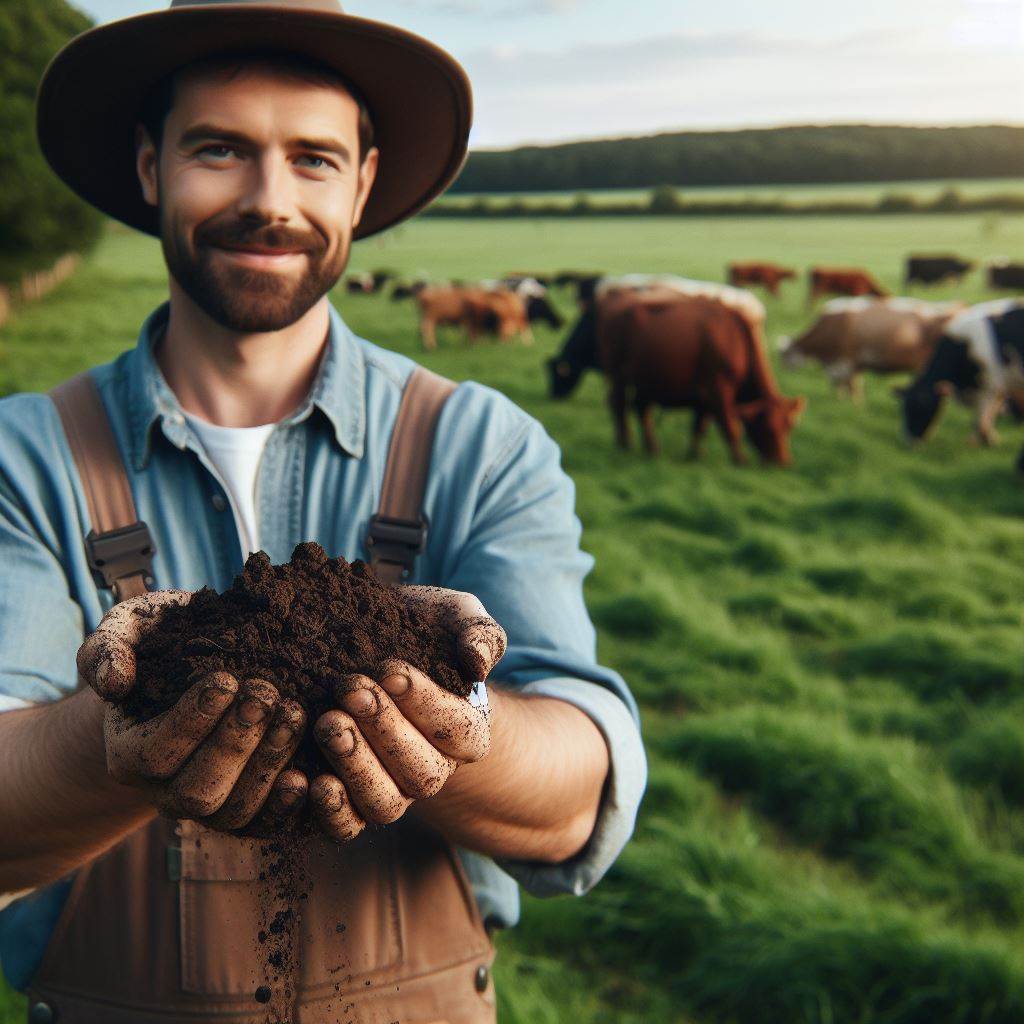Introduction
Brief overview of cover crops
Cover crops are an essential tool in sustainable agriculture practices.
These plants are purposely grown to cover the soil and provide numerous benefits to the environment and farmers alike.
Cover crops, also known as green manure, are grown specifically to protect the soil from erosion, suppress weeds, and improve soil fertility.
They are typically planted during fallow periods or after cash crops have been harvested.
The primary goal is to cover the bare soil, preventing erosion caused by wind or water.
Importance of cover crops in climate change mitigation
The importance of cover crops in climate change mitigation cannot be overstated.
One of the key benefits is their ability to capture and store carbon dioxide from the atmosphere.
By photosynthesizing and converting carbon dioxide into organic matter, these crops help reduce greenhouse gas emissions and combat climate change.
Additionally, cover crops enhance soil health by increasing organic matter content and improving soil structure.
This leads to better water infiltration, nutrient cycling, and overall soil fertility.
By keeping the soil covered and protected, cover crops also contribute to reducing soil erosion and nutrient runoff, preventing pollution of nearby water bodies.
Furthermore, these crops promote biodiversity by providing habitat and food sources for beneficial insects and microorganisms.
This, in turn, helps control pests naturally and reduces the need for chemical pesticides.
Therefore, cover crops are heroes in the battle against climate change.
Their ability to protect the soil, capture carbon dioxide, and enhance soil health make them an invaluable tool for farmers and the environment.
Transform Your Agribusiness
Unlock your farm's potential with expert advice tailored to your needs. Get actionable steps that drive real results.
Get StartedBy incorporating cover crops into agricultural practices, we can take significant steps towards mitigating climate change and ensuring sustainable and resilient food systems for future generations.
Benefits of Cover Crops
Cover crops are a crucial tool in the battle against climate change.
They offer numerous benefits that contribute to the overall health and sustainability of agricultural systems.
In this section, we will explore the various advantages that cover crops provide.
Soil health improvement
- Increased organic matter content: By planting cover crops, farmers can boost the organic matter content in their soil. This organic matter improves soil structure and fertility, leading to healthier crops.
- Enhanced soil structure and fertility: Cover crops play a vital role in enhancing soil structure and fertility. Their extensive root systems help break up compacted soil, allowing for better water and nutrient absorption.
- Reduced erosion and nutrient loss: Cover crops act as a protective layer, preventing soil erosion and nutrient leaching. Their dense canopies shield the soil from the impact of heavy rain, reducing runoff and preserving valuable nutrients.
Weed suppression and pest control
- Natural weed control through smothering effect: Cover crops can suppress weed growth by outcompeting them for resources such as sunlight, water, and nutrients. Their dense growth shades out weeds, making it difficult for them to establish and thrive.
- Disrupting pest life cycles: Some cover crops release allelopathic compounds that deter pests, while others attract beneficial insects that prey on harmful pests. By disrupting pest life cycles, cover crops minimize the need for synthetic pesticides.
Moisture conservation
- Reduced evaporation and increased water infiltration: The dense cover provided by cover crops helps to reduce evaporation of soil moisture. Additionally, their extensive root systems create channels for water infiltration, allowing it to penetrate deeper into the soil.
- Drought mitigation and enhanced resilience: Cover crops improve the resilience of agricultural systems to drought conditions. Their ability to conserve moisture in the soil helps crops withstand periods of water scarcity, reducing the risk of yield loss.
Most importantly, the benefits of cover crops in the battle against climate change and the promotion of sustainable agriculture are undeniable.
Their ability to improve soil health, suppress weeds and pests, and conserve moisture make them vital tools for farmers worldwide.
By integrating cover crops into agricultural practices, we can take significant strides towards building a more resilient and environmentally friendly food system.
Read: Protecting Soil in a Warmer World
Carbon Sequestration Potential
Carbon sequestration, the process by which carbon dioxide is removed from the atmosphere and stored in plants and soils, plays a crucial role in mitigating climate change.
Cover crops are recognized as powerful tools in enhancing carbon sequestration in agricultural systems.
Understanding the factors influencing carbon sequestration potential and the evidence supporting cover crop effectiveness is essential for promoting sustainable farming practices.
Explanation of Carbon Sequestration
Carbon sequestration involves the uptake of atmospheric carbon dioxide by plants during photosynthesis, which is then converted into organic matter and stored in the soil.
Cover crops, planted specifically to improve soil health and protect against erosion during fallow periods, contribute significantly to this process.
Through their extensive root systems and biomass accumulation, cover crops capture and store carbon, thus reducing greenhouse gas emissions and enhancing soil fertility.
Factors Affecting Carbon Sequestration
- Crop Selection and Diversity: The choice of cover crop species significantly influences carbon sequestration rates. Diverse cover crop mixtures, including legumes, grasses, and brassicas, enhance soil organic matter content and foster microbial activity, leading to greater carbon storage.
- Management Practices: Implementing conservation tillage practices, such as no-till or reduced tillage, preserves soil structure and organic matter, thereby facilitating carbon sequestration. Additionally, incorporating cover crops into crop rotations and using cover crop residue as mulch further enhances carbon retention in the soil.
- Climate and Soil Conditions: Environmental factors, including temperature, precipitation, and soil type, influence the effectiveness of carbon sequestration by cover crops. Warmer climates with adequate moisture levels promote greater biomass production and carbon incorporation into the soil. Similarly, well-drained soils with high organic matter content are conducive to long-term carbon storage.
Studies and Evidence on Cover Crop Carbon Sequestration
- Statistical Data and Research Findings: Numerous studies have demonstrated the significant role of cover crops in carbon sequestration. Research conducted across various agricultural regions consistently shows that cover cropping leads to substantial increases in soil organic carbon levels, with rates ranging from 0.5 to 2 tons of carbon per hectare per year.
- Examples of Successful Cover Crop Systems: Successful cover crop systems, such as winter rye and crimson clover mixtures or hairy vetch and cereal rye combinations, have been documented to sequester large amounts of carbon while providing additional benefits such as weed suppression and nutrient cycling. These examples highlight the potential of cover crops to contribute to climate change mitigation while improving soil health and productivity.
In essence, cover crops offer a promising solution for enhancing carbon sequestration in agricultural systems.
By selecting diverse cover crop mixtures, adopting appropriate management practices, and considering local climate and soil conditions, farmers can maximize carbon storage potential while promoting sustainable farming practices.
Continued research and adoption of cover cropping strategies are essential for addressing climate change challenges and building resilient agricultural ecosystems.
Read: Climate Change: Its Effects on Soil Health

Climate Change Mitigation
Climate change is one of the greatest challenges facing our planet today.
The increasing concentration of greenhouse gases in the atmosphere leads to rising global temperatures, extreme weather events, and other detrimental effects on the environment.
To combat climate change, various strategies are being implemented, and cover crops have emerged as heroes in this battle.
Reduction of Greenhouse Gas Emissions
One of the key contributions of cover crops towards climate change mitigation is the reduction of greenhouse gas emissions.
Greenhouse gases, such as carbon dioxide (CO2), methane (CH4), and nitrous oxide (N2O), trap heat in the atmosphere, leading to global warming. Cover crops address this issue in two significant ways.
- Erosion Control and Preserving Soil Organic Carbon
- Decreased Reliance on Synthetic Fertilizers
Improved Resiliency and Adaptive Capacity
In addition to reducing greenhouse gas emissions, cover crops improve the resiliency and adaptive capacity of agricultural systems in the face of climate change.
Showcase Your Farming Business
Publish your professional farming services profile on our blog for a one-time fee of $200 and reach a dedicated audience of farmers and agribusiness owners.
Publish Your Profile- Mitigating Extreme Weather Events
- Supporting Crop Productivity under Changing Climate Conditions
In fact, cover crops offer multiple advantages in the battle against climate change.
Their ability to reduce greenhouse gas emissions, preserve soil organic carbon, decrease reliance on synthetic fertilizers, and improve resiliency and adaptive capacity make them valuable tools for sustainable agriculture.
By implementing cover crop practices, farmers can contribute to climate change mitigation and ensure the long-term viability of agricultural systems.
Read: Adapting Farming to Climate Shifts
Challenges and Considerations
Cover crops have gained recognition for their numerous environmental benefits and their pivotal role in mitigating climate change.
However, there are still challenges and considerations that need to be addressed in order to maximize their potential effectiveness.
This section will explore some of the key challenges and considerations that surround the use of cover crops.
Initial costs and economic feasibility
One of the main challenges faced by farmers when considering the establishment of cover crops is the initial costs involved.
Implementing cover crops requires investments in seeds, equipment, and management practices.
However, it is important to strike a balance between these short-term costs and the long-term benefits that cover crops can provide.
It is crucial for farmers to understand that cover crops bring about significant long-term advantages, such as improved soil health, increased water retention, and reduced erosion.
These benefits translate into improved crop yields and reduced inputs over time.
Therefore, although the initial investment may be higher, it is important to consider the potential long-term economic feasibility.
Moreover, government agencies, conservation organizations, and agricultural initiatives often provide financial assistance and incentives to promote the establishment of cover crops.
These programs help offset the initial investment and encourage farmers to adopt sustainable practices.
Farmers should explore these opportunities and take advantage of the available resources to make cover cropping economically viable.
Knowledge and adoption gaps
Another challenge arises from the lack of knowledge and adoption gaps surrounding cover crops.
Many farmers may not be aware of the benefits and techniques associated with cover cropping.
To address this gap, establishing awareness and education programs becomes essential.
Efforts should be made to disseminate information about the advantages of cover crops, best practices for their implementation, and success stories from farmers who have experienced positive outcomes.
These educational programs can take the form of workshops, seminars, or online resources, reaching out to farmers and agricultural communities nationwide.
In addition to education, encouraging farmer engagement and knowledge sharing plays a crucial role in promoting cover crop adoption.
Peer-to-peer learning platforms and farmer networks can facilitate the exchange of experiences, challenges, and solutions related to cover cropping.
This knowledge sharing helps overcome barriers and provides practical insights to farmers who are considering adopting cover crops.
Collaborative initiatives involving agricultural extension services, research institutions, and farming communities can also foster knowledge sharing and create a supportive environment for farmers seeking guidance.
The establishment of demonstration sites, where farmers can witness the benefits of cover crops firsthand, can be instrumental in building confidence and trust in the practice.
Cover crops significantly benefit the environment and combat climate change but require addressing challenges and considerations.
Managing initial costs involves weighing short-term expenses against long-term gains and utilizing financial aid.
Bridging knowledge gaps entails awareness programs, education, farmer engagement, and knowledge sharing initiatives.
By addressing these challenges, cover crops can truly become heroes in the battle against climate change.
Read: Smart Watering: Tech Solutions in Farming
Conclusion
Recap of cover crop benefits and climate change mitigation potential
Cover crops play a crucial role in mitigating climate change by reducing soil erosion and nutrient run-off, improving soil health, and sequestering carbon dioxide.
They also provide valuable habitat for beneficial insects and wildlife.
Encouragement for farmers to consider implementing cover crops
Given the numerous benefits of cover crops, farmers should seriously consider incorporating them into their agricultural practices.
Not only do cover crops help to improve the productivity and sustainability of farms, but they also contribute to the overall health of the planet.
Importance of collaboration and sharing success stories
Collaboration among farmers, researchers, and policymakers is crucial for promoting the widespread adoption of cover crops.
Sharing success stories and best practices can inspire and motivate more farmers to implement cover crops, leading to significant positive impacts on the environment.




